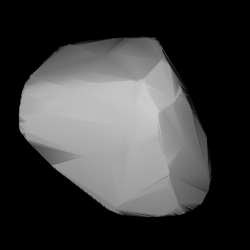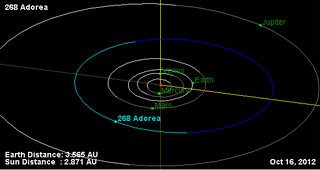3850 Peltier, provisional designation 1986 TK2, is a Florian asteroid and suspected interloper from the inner regions of the asteroid belt, approximately 4 kilometers in diameter. It was discovered on 7 October 1986, by American astronomer Edward Bowell at Lowell's Anderson Mesa Station, near Flagstaff, Arizona. The asteroid was named after American amateur astronomer Leslie Peltier.

Klymene is a large, dark Themistian asteroid that was discovered by J. C. Watson on September 13, 1868, and named after one of the many Clymenes in Greek mythology. It is orbiting the Sun with a period of 5.60 years and an eccentricity of 0.16. The orbital plane is inclined by 2.8° to the plane of the ecliptic. It is classified as a C-type asteroid, indicating it probably has a carbonaceous composition. The spectra indicates the presence of aqueous-altered minerals on the surface based upon a sharp feature at a wavelength of 3 μm, and, as of 2015, is the only member of the Themis family found to show this absorption.

Protogeneia is a large main belt asteroid that was discovered by Hungarian astronomer Lipót Schulhof on July 10, 1875, from the Vienna Observatory; it was his only asteroid discovery. Its name is Greek for "first born" and was chosen by Karl L. Littrow in allusion to the fact that this was the first asteroid discovered by an astronomer who was already known for work in other fields of astronomy.

Urda is a main-belt asteroid that was discovered by German-American astronomer Christian Heinrich Friedrich Peters on August 28, 1876, in Clinton, New York, and named after Urd, one of the Norns in Norse mythology. In 1905, Austrian astronomer Johann Palisa showed that the asteroid varied in brightness.

268 Adorea is a very large main belt asteroid, about 140 km in width. It was discovered by A. Borrelly on 8 June 1887 in Marseilles. This asteroid is a member of the Themis family and is classified as a primitive carbonaceous F-type/C-type asteroid. It is orbiting the Sun at a distance of 3.09 AU with an orbital eccentricity (ovalness) of 0.14 and a period of 5.44 yr. The orbital plane is tilted at an angle of 2.44° to the plane of the ecliptic.

Alice is a stony background asteroid from the inner region of the asteroid belt. It was discovered by Johann Palisa on 25 April 1890 at the Vienna Observatory.

Brasilia is a large Main belt asteroid that was discovered by French astronomer Auguste Charlois on 20 May 1890 in Nice. It is the namesake of the Brasilia family, a smaller asteroid family of X-type asteroids in the outer main-belt. However, Brasilia is a suspected interloper in its own family.
Friederike is a minor planet orbiting in the asteroid belt. It is a member of the Hygiea family of asteroids.
750 Oskar is a minor planet, specifically an asteroid orbiting in the asteroid belt that was discovered by Johann Palisa on 28 April 1913 in Vienna. Photometric observations made in 2012 at the Organ Mesa Observatory in Las Cruces, New Mexico, produced a light curve with a period of 6.2584 ± 0.0002 hours and a brightness variation of 0.21 ± 0.02 in magnitude. This is a member of the Nysa family of asteroids that share similar orbital elements.
1764 Cogshall, provisional designation 1953 VM1, is a carbonaceous Themistian asteroid from the outer regions of the asteroid belt, approximately 26 kilometers in diameter. It was discovered on 7 November 1953, by astronomers of the Indiana Asteroid Program at Goethe Link Observatory in Indiana, United States. The asteroid was named after Wilbur Cogshall, professor of astronomy at Indiana University.
5642 Bobbywilliams, provisional designation 1990 OK1, is an eccentric, stony asteroid and Mars-crosser from the inner regions of the asteroid belt, approximately 4.7 kilometers in diameter.
3034 Climenhaga is a stony Florian asteroid and synchronous binary asteroid from the inner regions of the asteroid belt, approximately 7.8 kilometers in diameter. The asteroid was discovered on 24 September 1917 by German astronomer Max Wolf at Heidelberg Observatory in southwest Germany and assigned provisional designation A917 SE. It was later named after Canadian astrophysicist John Climenhaga. Its minor-planet moon has a period of nearly 19 hours.
2658 Gingerich, provisional designation 1980 CK, is a background asteroid and a suspected synchronous binary system from the outer regions of the asteroid belt, approximately 13 kilometers in diameter. It was discovered on 13 February 1980, by astronomers of the Harvard College Observatory at the George R. Agassiz Station near Harvard, Massachusetts, in the United States. The presumed carbonaceous C-type asteroid has a short rotation period of 2.9 hours. It was named after Harvard astronomer Owen Gingerich.
4951 Iwamoto, provisional designation 1990 BM, is a stony, synchronous binary asteroid and slow rotator from the inner regions of the asteroid belt, approximately 5.5 kilometers in diameter. It was discovered on 21 January 1990, by Japanese astronomers Yoshikane Mizuno and Toshimasa Furuta at Kani Observatory in Japan.
5481 Kiuchi, provisional designation 1990 CH, is a bright binary Vestian asteroid from the inner regions of the asteroid belt, approximately 4 kilometers in diameter. It was discovered on 15 February 1990, by Japanese astronomers Kin Endate and Kazuro Watanabe at Kitami Observatory in Hokkaidō, Japan, and named after their colleague Tsuruhiko Kiuchi. The V-type asteroid has a rotation period of 3.6 hours.

1691 Oort, provisional designation 1956 RB, is a rare-type carbonaceous Themistian asteroid from the outer region of the asteroid belt, approximately 33 kilometers in diameter.
2104 Toronto, provisional designation 1963 PD, is a metallic background asteroid from the outer regions of the asteroid belt, approximately 36 kilometers in diameter. It was discovered on 15 August 1963, by Karl Kamper at the David Dunlap Observatory on plates taken by Sidney van den Bergh at the Karl Schwarzschild Observatory in Tautenburg, Germany. The asteroid was named after the University of Toronto. It was the first asteroid discovered at an observatory in Canada.

2590 Mourão is a bright Vesta asteroid from the inner regions of the asteroid belt, approximately 7 kilometers in diameter. It was discovered on 22 May 1980, by Belgian astronomer Henri Debehogne at ESO's La Silla Observatory in northern Chile. The V-type asteroid has a rotation period of 15.6 hours. It was named after Brazilian astronomer Ronaldo Rogério de Freitas Mourão.
10208 Germanicus, provisional designation 1997 QN1, is a stony Florian asteroid and binary system from the inner regions of the asteroid belt, approximately 3.5 kilometers in diameter.
15268 Wendelinefroger, provisional designation 1990 WF3, is a stony, spheroidal, and binary Nysian asteroid from the inner regions of the asteroid belt, approximately 3.4 kilometers in diameter.








